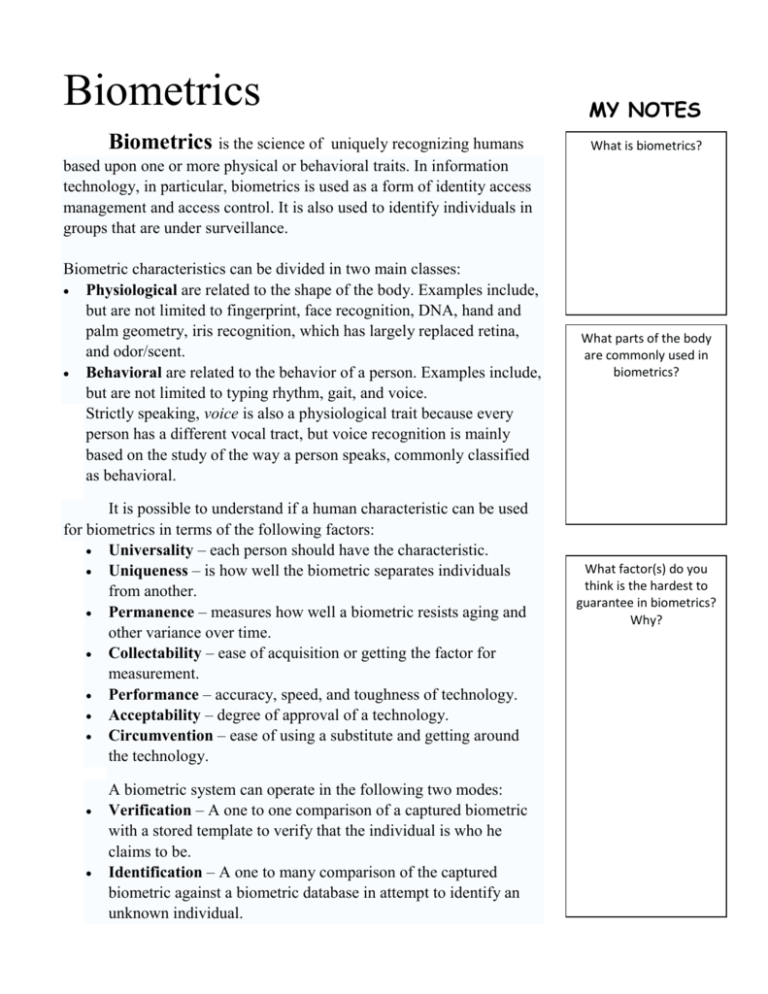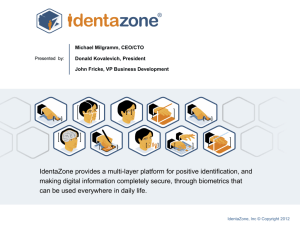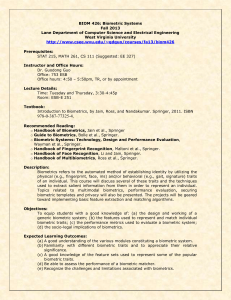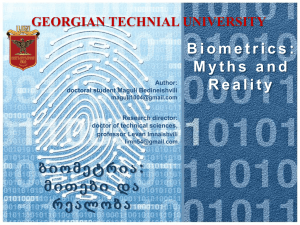What is one disadvantage of biometrics?
advertisement

Biometrics Biometrics is the science of uniquely recognizing humans based upon one or more physical or behavioral traits. In information technology, in particular, biometrics is used as a form of identity access management and access control. It is also used to identify individuals in groups that are under surveillance. Biometric characteristics can be divided in two main classes: Physiological are related to the shape of the body. Examples include, but are not limited to fingerprint, face recognition, DNA, hand and palm geometry, iris recognition, which has largely replaced retina, and odor/scent. Behavioral are related to the behavior of a person. Examples include, but are not limited to typing rhythm, gait, and voice. Strictly speaking, voice is also a physiological trait because every person has a different vocal tract, but voice recognition is mainly based on the study of the way a person speaks, commonly classified as behavioral. It is possible to understand if a human characteristic can be used for biometrics in terms of the following factors: Universality – each person should have the characteristic. Uniqueness – is how well the biometric separates individuals from another. Permanence – measures how well a biometric resists aging and other variance over time. Collectability – ease of acquisition or getting the factor for measurement. Performance – accuracy, speed, and toughness of technology. Acceptability – degree of approval of a technology. Circumvention – ease of using a substitute and getting around the technology. A biometric system can operate in the following two modes: Verification – A one to one comparison of a captured biometric with a stored template to verify that the individual is who he claims to be. Identification – A one to many comparison of the captured biometric against a biometric database in attempt to identify an unknown individual. MY NOTES What is biometrics? What parts of the body are commonly used in biometrics? What factor(s) do you think is the hardest to guarantee in biometrics? Why? What can happen if the biometric is really secure and a thief is determined to gain access to the information? The first time an individual uses a biometric system is called an enrollment. During the enrollment, biometric information from an individual is stored. In subsequent uses, biometric information is detected and compared with the At Walt Disney World biometric information stored at the time of measurements are taken from the fingers of guest to ensure that the person's ticket is enrollment. Note that it is crucial that used by the same person from day to day. storage and retrieval of such systems themselves be secure if the biometric system is to be robust, or tough. When thieves cannot get access to secure properties, there is a chance that the thieves will stalk and assault the property owner to gain access. If the item is secured with a biometric device, the damage to the owner could be irreversible, and potentially cost more than the secured property. For example, in 2005, Malaysian car thieves cut off the finger of a Mercedes-Benz S-Class owner when attempting to steal the car. The modern science of using the body to verify a person's identity dates back to 1882, when Frenchman Alphonse Bertillion proposed a forensic system of identifying people based on the size of their bodies, heads and limbs. This system quickly lost favour, however, to an alternative method of fingerprint analysis (dactyloscopy) that was described in the late 1800s by English scientist Sir Francis Galton and adopted by Scotland Yard in 1901 after being formally developed by Sir Edward Henry. Cancelable biometrics One advantage of passwords over biometrics is that they can be re-issued. If a token or a password is lost or stolen, it can be cancelled and replaced by a newer version. This is not naturally available in biometrics. If someone’s face is compromised from a database, they cannot cancel or reissue it. Cancelable biometrics is a way in which to incorporate protection and the replacement features into biometrics. The United States government has become a strong advocate of biometrics with the increase in fear of terrorism since September 11, 2001. The FBI is currently spending $1 billion to create a new biometric database, which will store DNA, fingerprints, and other biometric data. What types of biometrics have been used for years? What is one disadvantage of biometrics? The computers running the database will be contained in an underground facility about the size of a football field. Both the Department of Homeland Security and DARPA are heavily funding research into facial recognition systems. The Information Processing Technology Office, ran a program known as Human Identification at a Distance which developed technologies that are capable of identifying a person at up to 500 ft by their facial features. Starting in 2005, US passports with facial (image-based) biometric data were scheduled to be produced. Privacy activists in many countries have criticized the technology's use for the potential harm to civil liberties, privacy, and the risk of identity theft. Currently, there is some apprehension in the United States (and the European Union) that the information can be "skimmed" and identify people's citizenship remotely for criminal intent, such as kidnapping. Biometric technologies have been found in a number of popular cinema released films. This alone has created an interest, from general consumers, as a means of identifying oneself. In 2003 both X-Men 2 and Hulk used biometric recognition technologies in the form of hand access control in X-Men 2 and fingerprint access in Hulk. It wasn't however until 2004 when iRobot was released, starring American actor, Will Smith, that biometrics were truly showcased. The film set well into the future had some of the most advanced technologies on show, many of which hadn't, and still have not been developed today. The usage however of voice and palm recognition in the film cemented the futuristic look of the film in the audiences' mind, and both of which are in constant use today for securing buildings or sensitive data, these though just being two of many applications. What agencies and companies use biometrics? How does the general public typically know about biometrics? Where in your life are biometrics used? Adapted from http://www.biometricsaustralia.com/article.html and http://www.biometrics.org/introduction.php Comprehension questions: 1. What parts of the body are vital in biometric identification? 2. What method of biometric identification do you think is the most accurate? 3. Why might some people disagree with biometric identification? 4. How might biometric identification make your future more secure?





